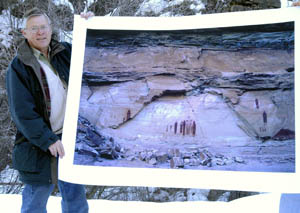Professor records sacred ground
Traces of ancient civilizations lie beyond the trails and campsites of Utah’s National Parks and only a privileged few are allowed to tread this sacred ground.
Although Craig Law cannot tell you the location of the rock art he has photographed, his kitchen table-sized prints portray brilliant images almost equal the originals.
Law started as a photo journalist for the University of Utah’s daily newspaper The Chronicle. Later he did social documentary work on Mormon culture and social gatherings. Today he works as a professor at Utah State University who works on national park research projects in his spare time.
Law’s love of photography extends back to his years as a boy Scout. When he was young his family would go on vacation in Southern Utah and Law found he loved the change of desert. Now Law works in coordination with writer David Susec. The two organized non-profit, getting grants for photo expeditions.
“We wanted to document what hadn’t been documented. The first few years we didn’t get much information from the authorities. They all thought we were new age hippies, but slowly we gained their respect and confidence,” Law said.
In the spring and fall Law and Susec head out into the wilds of Utah. A typical day involves 30 miles of 4-wheel drive and then at least four to five miles of hiking. Packing 70 pounds in equipment and supplies the two document paintings that are 5,000-6,000 years old. Originally they believed they could document everything in just a few years, but now after visiting more than 275 sites they believe decades of work lie ahead.
“It’s a rare privilege and a lot of hard, sweaty work. Beautiful things to look at. Many people go backpacking for vacation, I do this for research,” said Law. “These are special places, they’ve lasted that long on a rock wall, not in a protected museum. It’s amazing they’ve lasted that long. These sites need to be protected and they need the documentation done. I try to make my imagery strong artistically; if it looks beautiful I think people are more inclined to preserve it than if it is ugly.”
Law and Susec have had much of their work published including a book called “Sacred Images” and a publication in the March 2005 issue of Smithsonian Magazine.
“I was delighted with the article. They had to cut the article form 5,000 words to 1,000 words so it doesn’t cover everything, but the exposure in the magazine is wonderful,” said Law.
Currently, Law and Susec are working on getting funding and approval to do a major exhibit at the Smithsonian. The exhibit would be on Native American rock art in the South-West. If all goes well the exhibit will be up in a few years.
Although Law gets special permission from the Parks Service to photograph rock art in level three sites, a lot of the areas he has photographed are open to the public. Often, his wife Nancy will go with him and every spring Law takes photo majors to Southern Utah.
“The photo program has helped me to find my inner self thru images,” said Cassie Olson, a junior majoring in photography.
Law started out at the University of Utah, but switched to Utah State University because the U didn’t offer his emphasis. He taught at USU as a graduate student and after graduation was asked to be a temporary teacher. He was tenured after two years and is currently finishing his 27th year.
“Craig is a master of techniques and he is good at helping people work on detail. He’s like a grandpa, he’s the nurturing one in the department,” said Robyn Tingy, a junior majoring in photography.
-amcconkie@cc.usu.edu

